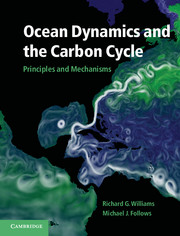Book contents
- Frontmatter
- Contents
- Preface
- Acknowledgements
- Illustration credits
- Part I Introduction
- Part II Fundamentals
- Part III Physical Phenomena and their Biogeochemical Signals
- 7 Seasonality of the upper ocean
- 8 Ocean gyres and intense currents
- 9 Ocean eddies
- 10 Ventilation
- 11 Cycling and transport of nutrients and carbon
- 12 The deep ocean and overturning
- Part IV Synthesis
- Appendix
- Symbols and definitions
- Glossary
- Answers
- References
- Index
- Plate section
12 - The deep ocean and overturning
from Part III - Physical Phenomena and their Biogeochemical Signals
Published online by Cambridge University Press: 05 June 2012
- Frontmatter
- Contents
- Preface
- Acknowledgements
- Illustration credits
- Part I Introduction
- Part II Fundamentals
- Part III Physical Phenomena and their Biogeochemical Signals
- 7 Seasonality of the upper ocean
- 8 Ocean gyres and intense currents
- 9 Ocean eddies
- 10 Ventilation
- 11 Cycling and transport of nutrients and carbon
- 12 The deep ocean and overturning
- Part IV Synthesis
- Appendix
- Symbols and definitions
- Glossary
- Answers
- References
- Index
- Plate section
Summary
The deep ocean is puzzling and intriguing, a vast expanse of cold water below the thermocline, slowly moving around the globe. For much of the time, these deep waters are isolated from the atmosphere and only reach the surface in a few remote regions. Most deep waters are very old, many years have elapsed since these waters were last in contact with the atmosphere, so their properties provide a memory of the past atmosphere. Up to now, only a small fraction of the deep waters carry any signal of anthropogenic CFCs or fossilfuel derived carbon dioxide.
At the simplest level, the deep circulation is connected to dense waters forming in the high latitudes through interactions with the atmosphere or overlying ice, which eventually sink and spread beneath lighter waters. The effect of the surface forcing is not the entire story. The vertical ordering of dense waters is affected by intense mixing at overflows, where dense waters plunge down sloping topography and are blended and diluted with the background waters. These composite water masses then spread far over a basin and even the globe. Dense waters eventually return to the sea surface, preferentially over the Southern Ocean.
In this chapter, we firstly provide a descriptive overview of the deep ocean and why the overturning is so different in the northern basins. Secondly, we provide a mechanistic view of the processes affecting dense water, focussing on examples in the North Atlantic, including convection, cascading, overflows, mixing in fracture zones and overturning.
- Type
- Chapter
- Information
- Ocean Dynamics and the Carbon CyclePrinciples and Mechanisms, pp. 290 - 326Publisher: Cambridge University PressPrint publication year: 2011



